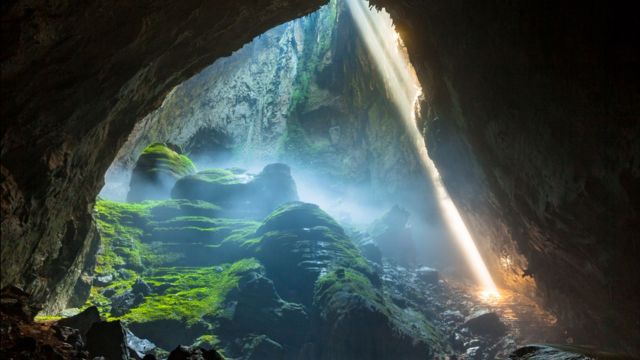Caves are nature’s clandestine masterpieces, hidden away from the light of day, offering a glimpse into the depths of the Earth’s crust. These natural voids, formed through the ceaseless toil of geological processes, vary greatly in size and shape, each telling a unique story of the planet’s past.
Particularly fascinating are the longest caves in the world, predominantly found within the karst landscapes where soluble rocks give way to the formation of extensive underground networks. This article delves into the ten longest caves globally, with a special focus on regions rich in these geological wonders, such as southern Kentucky’s Pennyroyal Plateau, South Dakota’s Black Hills, and Mexico’s Yucatan Peninsula.
The Earth’s Most Extensive Subterranean Networks
- Mammoth Cave: Stretching over 426 miles, Mammoth Cave in south-central Kentucky is the pinnacle of cave systems worldwide. Encased within Mammoth Cave National Park, this colossal network sits atop a foundation of limestone, beneath which a layer of sandstone creates a natural roof. Its formation, a marvel of nature, owes to water seeping through sinkholes, gradually dissolving the limestone and carving out vast chambers and intricate passageways. Beyond its geological significance, Mammoth Cave has a rich biodiversity, hosting over 130 subterranean species. With human interactions dating back to the early 19th century, it has evolved into a revered site for exploration and leisure, offering a blend of historical insights and natural beauty.
- Sistema Ox Bel Ha: The “Three Paths of Water,” as known in Yucatec Maya, is the planet’s longest underwater cave and the second-largest cave system, with a surveyed length of 270.8 miles. Located near Tulum in Quintana Roo, Mexico, this sprawling network of limestone caverns discovered in 1996, boasts more than 150 cenotes—natural pits or sinkholes—serving as windows to an aquatic realm. The cave system is a significant archaeological site, with prehistoric human remains suggesting its use as a burial site.
- Shuanghedong Cave Network: Asia’s and China’s longest cave, and the third-longest globally, spans approximately 249 miles in Guizhou province. This network features over 105 entrances and a myriad of waterfalls and underground rivers. Discovered in 1987, its exploration has unveiled a more extensive system than initially thought, now accessible for tourism through the Suiyang Shuanghedong National Geopark.
- Sistema Sac Actun / Sistema Dos Ojos: This 239.9-mile-long network on the Yucatan Peninsula’s Caribbean coast became the world’s fourth-longest cave system following the discovery of its connection to the neighboring Sistema Dos Ojos in 2018. The caves, adorned with a tapestry of geological and archaeological marvels, are a testament to the region’s complex geological and human history.
- Jewel Cave: With 217.3 miles of mapped passageways, South Dakota’s Jewel Cave is the fifth-longest cave, offering a spectacle of calcite crystals and various speleothems. Its unique ecosystem and historical significance as a National Monument since 1908 make it a fascinating site for exploration and study.
- Optymistychna Cave: Known as the longest gypsum cave and the sixth-longest globally, this 164.4-mile-long network beneath Ukraine’s Ternopil Oblast is a labyrinthine wonder. Its discovery in 1966 opened a new chapter in the study of subterranean ecosystems and geological formations.
- Wind Cave: As the seventh-longest cave with 161.7 miles of explored passageways, South Dakota’s Wind Cave is remarkable for its complex boxwork formations and the constant breeze at its entrance. It underscores the diverse geological processes that sculpt the Earth’s subterranean landscapes.
- Clearwater Cave System: Malaysia’s Gunung Mulu National Park is home to the eighth-longest cave, part of one of the world’s largest interconnected systems by volume. First explored in the late ’70s, it has since been a focal point of speleological research and ecotourism.
- Lechuguilla Cave: Nestled in New Mexico’s Carlsbad Caverns National Park, Lechuguilla is the ninth-longest cave, celebrated for its rare formations and pristine condition. It offers profound insights into geological and biological processes in deep cave environments.
- Fisher Ridge Cave System: Rounding out the top ten is Kentucky’s Fisher Ridge Cave System, a 131.8-mile-long network near the famed Mammoth Cave National Park. Its discovery in 1981 has fueled ongoing exploration, hinting at a possible connection to the Mammoth Cave system and further underscoring the complexity and vastness of the Earth’s subterranean realms.
The Pursuit of Knowledge
Caves are not just geological formations but living museums, harboring secrets of the Earth’s past and present. They challenge our understanding of life in extreme environments and serve as natural laboratories for scientific discovery. Whether through the lens of a spelunker or a scientist, these longest caves invite us to explore deeper into the heart of our planet, reminding us of the wonders and mysteries that lie just beneath our feet.

